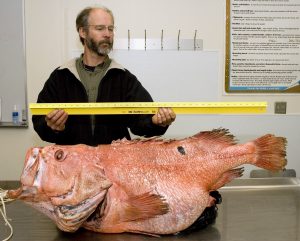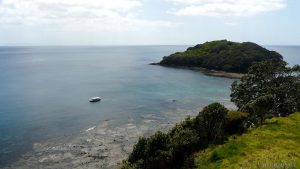Evolution of Motherhood: The Importance of Mature Female Fish
By Daniela Ferraro, RJD Intern
Older, female fish are becoming a necessity for the continuation of trophy-fish hunting and sustainable commercial fishing. Looking at both freshwater and saltwater species, the presence of larger, more mature fish increases the productivity and stability of fish populations. Dr. Mark Hixon, of the University of Hawai’i at Manoa, refers to the loss of big fish as “size and age truncation.” Big, old, fat, fertile, female fish, affectionately nicknamed BOFFFFs, have proved the ability to produce significantly more eggs than younger fish. They also can spawn at different times and places, allowing them the option of evading potential predators and threats to their offspring. Efforts to protect older, larger fish include creation of marine reserves, which act as no-take zones. Marine reserves allow fish to spawn throughout their entire lives. As large fish, BOFFFFs are a valuable commodity in commercial fishing, as fisheries tend to target marketable commodities. This specified targeting alters a fishery’s modes and methods: through the narrowing of mesh size or gear type. Drift nets and long lines are used in the removal of larger fish from certain populations. To some extent, even bait type and hook affects the type of fish caught. Slot limits are placed on commercial fisheries, limiting them to catching only medium-sized fish. Although egg size variation among a single species may be narrow, across a diverse range, significant maternal effects have been noted in terms of larger egg size.

BOFFFFs: Big (1.1m), old (ca.100 years), fat (27.2 kg), fertile female fish: Shortraker rockfish (Sebastes borealis). Image Source: Karna McKinney, Alaska Fisheries Science Center, NOAA Fisheries Service
More mature females produce more, and often larger, eggs that typically develop into larvae that can withstand more intense challenges like starvation and have a faster growth rate. This is partly due to the physical body size, as a larger fish translates to a wider body cavity to allow for the development of larger ovaries. BOFFFFs have a tendency towards earlier and longer spawning seasons. With this flexibility, these fish can withhold spawning in unfavorable conditions. Once the danger of predation, or other threats, has passed, BOFFFFs can spawn abundantly and improve recruitment. Hixon refers to this phenomenon as the storage effect. This ability is preferential when considering commercial and differential fishing. The targeted removal of BOFFFFs results in a truncation of size and age structure of a specific population. The removal of older fish from an overfished population will increase their probability of species collapse. The assumption that younger female fish contribute equally to production and stock is detrimental to the future of sustainable fishery stocks.
Fishery productivity would find stability in the implementation of old-growth age structures. Berkeley suggested three methods to limit the overfishing of BOFFFFs: slot size limits with both minimums and maximums, low rates of fishing mortality, and marine reserves. This can be accomplished with enforcement of both marine reserve no-take zones as well as catch limits. Marine reserves act not only as a direct safe place for fish to thrive and procreate, but also as a healthy influence on surrounding waters. They give maturing fish an area to develop, spawn and seed nearby fisheries.
Marine reserves act to provide ecosystems and environments for fish to not only reach sexual maturity, but past that. In addition, larvae from healthy marine reserves are found to seed the areas directly adjacent. This will assist in the replenishment of overfished and exploited populations. By integrating large-scale marine reserves, it is believed that it is possible to halt and reverse the decline of global fisheries while also protecting marine teleost, mammal, and invertebrate species. The decrease in mortality due to the protection of species by marine reserves and the subsequent increase in productivity has been seen in both temperate and tropical locations. Since marine reserves are located along reefs, estuaries, and kelp beds, it provides a large range in the protection of a diversity of species.
In a study conducted by Steven Berkeley et al, featuring 20 female black rockfish (Sebastes melanops), from five to seventeen years, it was found that larval groups from the older females grew three times faster than their counterparts. Larvae from the older fish also survived starvation twice as long. According to Berkeley, this is due to the provision of larvae with energy-rich triaglycerol (TAG) lipids as they increase in age. The TAG volume found in oil globules is positively correlated with age, growth rate, and survival. However, maternal effects can’t be classified as consistent across every species of teleost fish. Instead, research indicates that maternal effects have developed across a diverse taxonomic range. With the removal of matured female fish, populations are more likely to develop damaging consequences in terms of biodiversity and productivity.
References
Berkeley, Steven A., Mark A. Hixon, Ralph J. Larson, and Milton S. Love. “Fisheries Sustainability via Protection of Age Structure and Spatial Distribution of Fish Populations.” Fisheries 85.5: 23-32. Print.
Gell, Fiona R., and Callum M. Roberts. “Benefits beyond Boundaries: The Fishery Effects of Marine Reserves.” Trends in Ecology & Evolution 18.9: 448-55. Print.
Hixon, M. A., Johnson, D.W., and Sogard, S. M. BOFFFFs: on the importance of conserving old-growth age structure in fishery populations. – ICES Journal of Marine Science, 71: 2171–2185.

